How to Propagate a Rosemary Plant from Stem Cuttings
This post may contain affiliate links, which means that I may receive a commission if you make a purchase using these links. As an Amazon Associate I earn from qualifying purchases.
Fresh rosemary is one of the most flavorful and fragrant herbs in the kitchen. Learn how to take rosemary cuttings from an established mother plant and grow new plants in containers that can be moved outside in summer and indoors in winter.

Rosemary (Rosmarinus officinalis) is a perennial herb in USDA Hardiness Zones 8 and warmer where it can be planted in the garden and can grow 4 feet tall and spreads about 4 feet wide depending on the variety.
For those of us gardening in colder zones, growing rosemary in containers allows us to bring it in during the winter to keep it alive.
My rosemary plant is going on seven years old this year. It grows in a container spends the summer outside on the porch. The rosemary plant is brought inside when the weather turns cold in fall, and it overwinters on a south-facing windowsill.
By the time spring rolls around, the rosemary usually looks raggedy from reduced light and heat fluctuations. Sometimes so many needles dry up and drop off that I wonder if it can possibly survive.
Once warmer weather arrives, the rosemary plant is hardened off, and returned outside for summer. After only a few weeks, it begins to grow new shoots, and the branches fill in with thicker foliage. I am amazed every time it happens.
This is the perfect time to start a new batch of plants. These fresh, green stems are the ones you want to select for softwood stem cuttings.
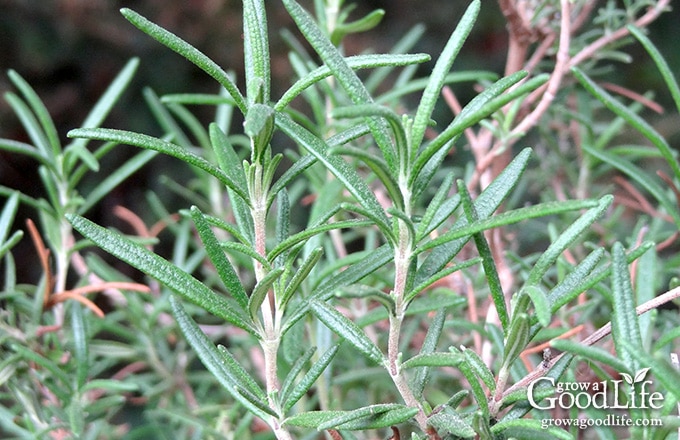
Benefits of Growing Rosemary Plants from Stem Cuttings
Instead of purchasing a new rosemary plant every year or starting new plants from seeds, try growing your own from stem cuttings. Some of the benefits of growing rosemary from cuttings vs. starting from seeds include:
- Earlier Harvest: A rooted rosemary plant from a cutting will mature quicker than a plant started from seed. Rosemary seeds tend to have low germination rates and take a long time to sprout and grow. A rosemary stem cutting will reach a usable size in just a few months, so you will be able to harvest rosemary sooner.
- Same as the Mother Plant: The rosemary plant you will grow from cuttings will be an exact clone of the mother plant and have the same flavor, disease resistance, and growth.
- Extra Plants for Free: A single plant can provide numerous cuttings without risking the health of the plant. So you can line your kitchen windowsill with several plants that will smell wonderful when you brush your hand against them.
How to Grow Rosemary from Cuttings
Here are steps to taking rosemary cuttings from an established mother plant and grow new rosemary plants in containers that can be moved outside in summer and indoors in winter.
Step 1: Select new shoots from the mother plant
Choose healthy stems with fresh growth. The younger shoots will have green stems that are flexible. Avoid older brown, woody stems.
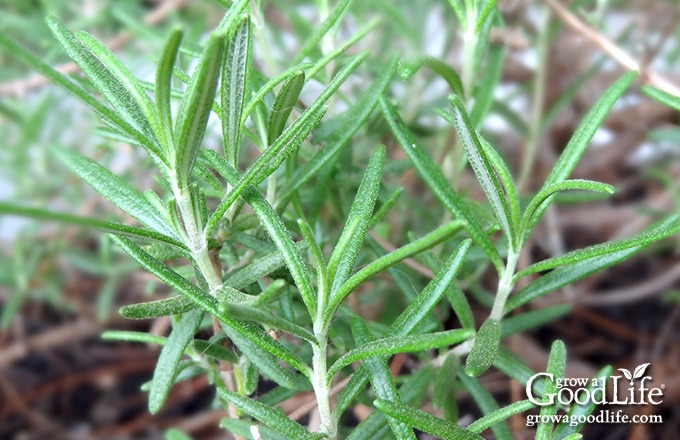
Step 2: Take stem cuttings
Use sharp scissors and snip the rosemary stem about 5 to 6-inches back from a fresh growing tip. Cut plenty of extra stems in case some fail to grow roots.
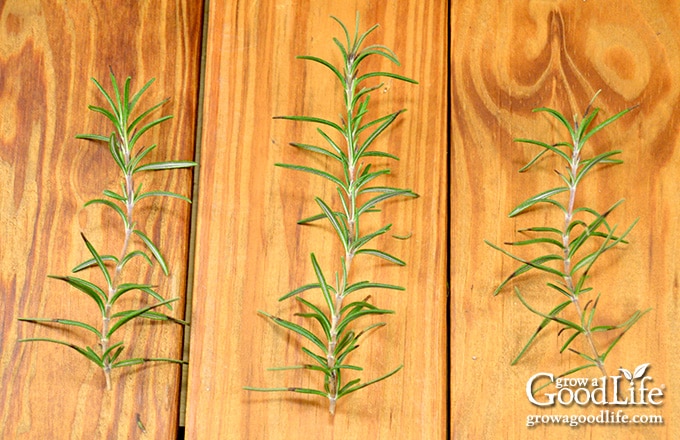
Step 3: Strip the lower leaves
Grasp your fingers around the stem, and gently strip off the lower 2-inches of needles from the stem of the rosemary cutting.
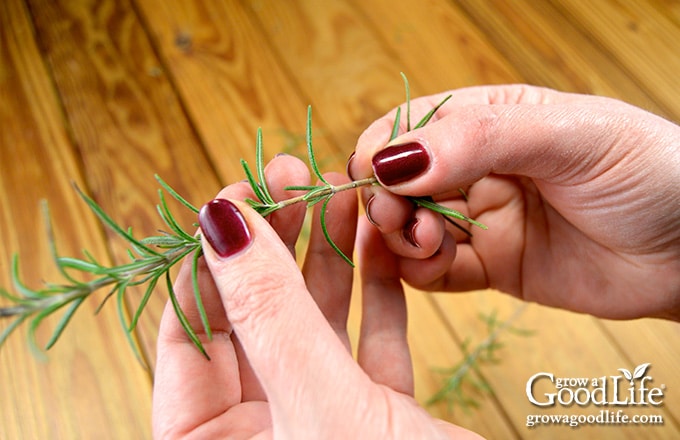
Step 4: Place cuttings in water
Stick the stems in a jar of water and place the jar in a warm place away from direct sunlight. Change the water every couple days, replacing with room temperature water. The fresh water provides dissolved oxygen and prevents the cuttings from rotting.
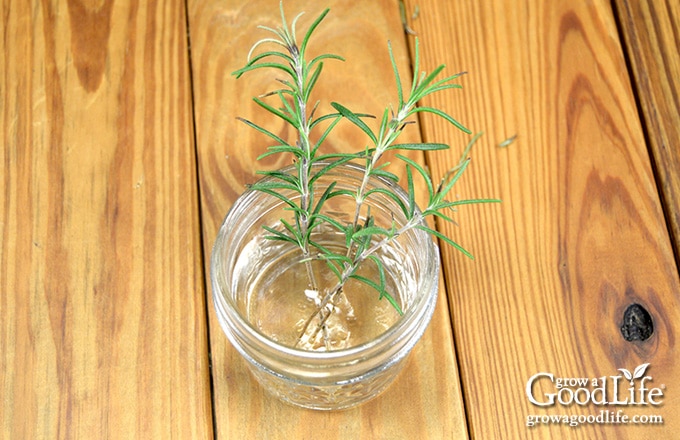
The rosemary stem cuttings should grow roots in a few weeks depending on the temperature. It can take longer in colder temperatures. After 4 to 8 weeks it should be apparent if the rosemary cuttings have survived. The cuttings that do not survive will be brown and shed needles. If your rosemary cutting is still alive, give it some more time.
Step 5: Pot up the stem cuttings once roots develop
Your rosemary cuttings are ready to place in soil when you see 4 to 6 roots on each stem that are at least 1/2-inch long. Use a sandy soil mix that drains well. Mix equal parts all-purpose potting soil and sharp sand. Or use cactus-potting soil. Use a sandy soil mix that drains well. Mix equal parts all-purpose potting soil and sharp sand. Or use cactus-potting soil.
Fill a 4-inch pot with slightly damp potting soil for each rosemary cutting. Use a pencil to make a 3 to 4-inch hole into the soil. Place the cutting in the hole with care to avoid damaging the roots. Cover gently and water thoroughly.
Place the newly potted rosemary plant in indirect light or in filtered sunlight until roots become established, and then move to direct light, at least 6 to 8 hours per day. Keep the potting soil moist until you see new growth.
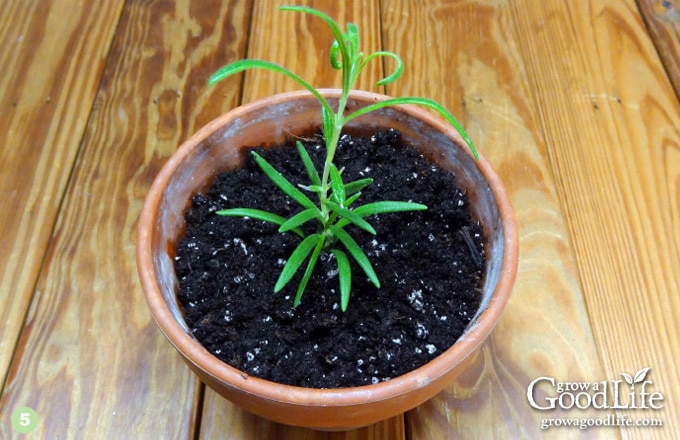
Let the new plants to put on some growth before harvesting. Once the plant is 6-inches tall, harvest by cutting stems as needed. New growth will continue forming on the stem. Rosemary grows slowly so don’t harvest more than 1/3 of the plant at one time.
How to Care for Rosemary Plants
Rosemary is a rather robust plant once it is established and growing. Here are some tips to keep your plant healthy and producing:
- Grow in a sunny location. Rosemary thrives in 6-8 hours of direct sun in the summertime.
- Water when the soil feels dry. Once established, rosemary likes to stay on the dry side. Allow top inch of soil to dry out between watering, and then water thoroughly.
- Re-pot as the plant gets larger and the roots fill the container. A rosemary plant that grows in a container can reach 1 to 3 feet high. Just keep transplanting to a larger container when the roots fill the pot.
- Prune rosemary frequently. The more you trim, the bushier the plant grows. Prune the plant after it flowers to keep it compact.
Tips for Growing Rosemary Indoors in Winter
Rosemary is native to Mediterranean climates so it prefers a hot, sunny, and humid atmosphere. Here are some tips for keeping your rosemary plants alive indoors during winter:
- Quarantine: If you have houseplants, it is a good idea to quarantine your rosemary plants when you bring them indoors. Keep the plants in a separate location for a while to be sure there are no hitchhikers, pests, or disease.
- Light: Locate your rosemary plants in a bright south-facing window. Alternatively, you can use grow lights and keep your plants happy during the winter months.
- Water: Try to keep the potting mix evenly moist. Over watering will cause the plant to rot. If the soil is too dry, the plant will wither and die. Water when the soil dries out at the surface and let the extra moisture drain.
- Temperature: Rosemary likes it a bit on the cooler side during the winter. Keep the plants away from heat sources and wood stoves. About 60 to 65 degrees is ideal.
- Humidity: Winter heating keeps us warm, but it also saps moisture from the air and drops the humidity. Compensate by misting your rosemary plant frequently, running a humidifier, or placing your rosemary plant on a tray of pebbles and water to increase the humidity around your plant.
- Pests and Diseases: Common pests for indoor rosemary plants are red spider mites, aphids, spittlebugs, and whiteflies. These pests suck on the plants and cause the foliage to wilt and dry up. Inspect your rosemary plants frequently for pests and control with organic insecticidal soap. Diseases such as root rot, powdery mildew, and mold are all signs of too much moisture and poor air circulation. Allow the top inch of soil to dry out between watering, and then water thoroughly allowing extra water to drain out of the bottom of the pot. Run a fan to improve air circulation around your plants.
This article was originally published March 23, 2015. It has been updated with additional information, new photos, and video.
You May Also Like:
Good planning is key to a successful vegetable garden
Whether you are new to growing your own food or have been growing a vegetable garden for years, you will benefit from some planning each year. You will find everything you need to organize and plan your vegetable garden in my PDF eBook, Grow a Good Life Guide to Planning Your Vegetable Garden.


I had started to propagate some rosemary last week and didn’t see any roots growing, so I gave up. Guess I wasn’t patient enough. I would love to have a rosemary hedge around the perimeter of our garden. The lovely blue flowers are an extra treat! Thanks for encouraging me to be more patient! ;0D
That’s a great idea. I’ll try starting some cutting when I do my gardening next week. I love rosemary as an herb and a lovely plant in the garden. – Margy
It definitely sounds easy enough for me. Looks like fun to do with kids so they can see the roots start in the water. Should they be put in soil as soon as the roots appear?
Yes, pot up the stem cuttings once roots develop. See step #5 above for the recommended soil mix. It can take a while for the roots to grow, just keep changing the water every few days to keep it fresh.
Another great tutorial! I do something similar with our lavender except I place in little pots of soil instead of water. I will have to try this 🙂
I love that you posted this! At our former home we had an old rosemary bush that was easily 4 feet tall! I have a smaller one now, but I would like to propagate more from it. I think I can handle this method!
Oh! And I am stopping by from the Back to Basics link up!
I look forward to doing this…. I love having rosemary and I am hoping my plant comes back and does well this year. 🙂
Your method roots the cuttings in water before you pot them up. I added a link to this page in my article ‘Grow Rosemary From Cuttings’ http://farmwhisperer.com/article/grow-rosemary-cuttings
Thanks Ken! I’m impatient and like to see the roots before planting in soil. Isn’t it wonderful to be able to grow new plants this way?
I live in SW France, clay soil, short hot summers, long wet winters & just break a branch (woody) stick it in the ground and it grows!
One of my favorite plants! And now I can propagate more. Don’t know why I never thought about rooting rosemary as I do other plants, and your post turned on the lightbulb ~ ah ha! Thanks for sharing 🙂 Bwg ~~~
My 2 year old rosemary plant bit the dust only a couple of months after being brought inside. I’m so horrible with indoor plants, that I suppose the real miracle was that I was able to overwinter it the first year!
You don’t need to overwinter rosemary! 😀
Hi Craig, I am not sure what your comment means. Rosemary is cold hardy to only 20°F (zone 9). Those of us in colder areas need to bring the plant indoors if we want it to survive.
I’m in zone 5.. I
cover mine when cold and open it up to sun when I can….its beautiful still.
Wow. Shannon, that is wonderful that you are able to keep your rosemary alive by covering it.
I live in zone 7 (mid-state North Carolina). I have had one ever spreading rosemary plant for at least 5 years. It’s planted in ground. I never bring it in. It’s one of the more robust plants in my garden.
Laurie, You are lucky! Rosemary does not survive our winters outside. We are in zone 5.
Rosemarinus ‘Arp’ is slightly more cold hardy, listed to Zone 6.
Where can I purchase rosemary seeds?
Hi Cheryl, Check out my Resources page for my favorite seed companies: https://growagoodlife.com/resources/
Don’t bother with seeds – just buy a package of fresh rosemary at the grocery store.
Rosemary seeds are said to have a low germination rate. None of my seeds (fresh) germinated.
Janet, Yes, I have only succeeded in growing rosemary once from seed. It took a long time to germinate and reach harvest size. It is much quicker to propagate from stem cuttings.
Not a single one of the entire pack I planted germinated this year either 🙁